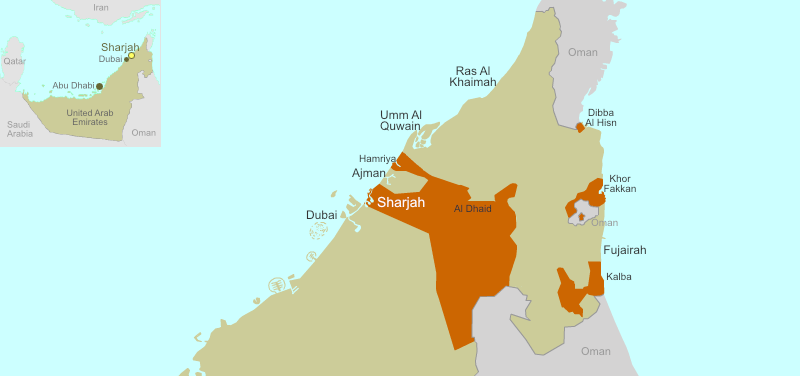For an optimal view of our website, please rotate your tablet horizontally.
Sharjah [al-Shariqah = the East, or: rising sun] is the third largest of the 7 emirates that make up the United Arab Emirates (UAE).

Emirate of Sharjah
Capital: city of Sharjah
Total area: aprox. 2,650 km2
Population, Emirate: 2.374 Million
City of Sharjah: 1,684,649 (in 2019)
Ruler:
HH Sheikh Dr. Sultan Bin Mohammed Al Qasimi, Member of the Supreme Council of United Arab Emirates and Ruler of Sharjah
With coastline on both the Arabian Gulf and the Gulf of Oman, Sharjah is the third largest emirate in the United Arab Emirates. Important geographic features include the two coastal areas, interior desert and rocky mountains in the eastern part of the emirate.
Sharjah has a long history as a geographic entity, with archaeological evidence of human civilisation reaching back at least 10,000 years. Excavations in the Mleiha area of Sharjah indicate that humans were already living in the area during the Neolithic Period, the Bronze Age and particularly the Iron Age (1200-400 BCE). Almost 600 years later, the Greek geographer Ptolemy included Sarcoa (Sharjah) on one of his maps, demonstrating international recognition of the Sharjah area.
From the sixteenth to nineteenth centuries, European powers such as Portugal, Holland and Britain became interested in Sharjah as they vied to control trade routes between the Mediterranean Sea and India. References to Sharjah can be found on a 1666 Dutch map, which accurately indicates the locations of Sharjah towns Calba (Kalba), Gorfocaan (Khorfakkan) and Dabba (Dibba), and an 1820 British Royal Navy map of the walled city of ‘Shargah’. In 1820, a treaty between Britain and local sheikhs gave the British control of Arabian Gulf trade routes. The relationship between the British and the Trucial States, the former name of the United Arab Emirates, continued until 1971, when the country gained its independence. His Highness Sheikh Dr Sultan Bin Mohammed Al Qasimi has been the ruler of Sharjah since 1972.
Sharjah’s strategic location and rich natural resources have been major factors in the emirate’s economic development. Sharjah had the first international airport in the Arabian Gulf, built by the British in 1932, and the first container port, constructed in 1976. In addition to the general trading activities, both fishing and pearling have played an important role in the Sharjah economy, but the pearling industry fell victim to strong competition from Japanese cultured pearls in the 1940s and lost its prominence.
The discovery of oil in 1972 and beginning of natural gas drilling in 1990 brought Sharjah new sources of income, allowing the emirate to develop rapidly into the successful cultural and business hub that it is today. However, since Sharjah’s oil and gas resources are limited, the economy has been diversified to include manufacturing, health care, environmental protection, tourism, transport and logistics as well. In recent years, the Sharjah government has established two economic free zones and increased investment opportunities in the emirate.
As a result of the important cultural initiatives of His Highness Sheikh Dr Sultan Mohammed Al Qasimi, member of the Federal Supreme Council and Ruler of Sharjah, Sharjah is recognised internationally as a cultural destination. In 1998, it was named UNESCO Cultural Capital of the Arab World, in 2014, the ISESCO Islamic Culture Capital, and for the year 2019, Sharjah was designated the UNESCO “World Book Capital.” These designations celebrate Sharjah’s leading role not only in supporting the arts, but also in furthering knowledge and appreciation of the emirate’s history, architecture, traditional culture and Islamic roots.
(From information of the Sharjah Art Foundation and other official sources.
© Map: Universes in Universe)
United Arab Emirates
Formed on 2nd December 1971 as a 6 member independent state, with the unification of Abu Dhabi, Dubai, Sharjah, Fujairah, Umm Al Quwain and Ajman, with Ras Al Khaimah joining in 1972 to complete the 7 emirate country.
Capital: Abu Dhabi
Total area: 83,600 km2
UAE Population: 9.89 Million (estimated in 2020)
Approx. 11.5% Emiratis, and 88.5% expats)